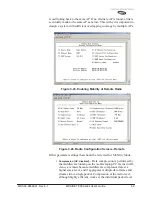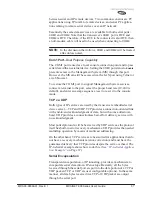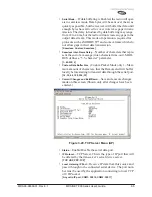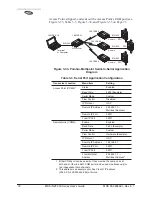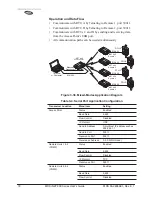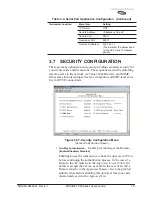
58
MDS iNET 900 Series User’s Guide
MDS 05-2806A01, Rev. E.1
When data is received by the radio through the serial port it is buffered
until the packet is received completely. There are two events that signal
an end-of-packet to the radio: a period of time since the last byte was
received, or a number of bytes that exceed the buffer size. Both of these
triggers are user configurable.
One radio can perform serial data encapsulation (IP-to-Serial) and talk
to a PC. Two radios (or one radio and a terminal server) can be used
together to provide a serial-to-serial channel.
TCP Client vs. TCP Server
On a TCP session there is a server side and a client side. The server is
always waiting for requests from clients. The transceiver can be config-
ured to act as either a server or a client.
The client mode attempts to establish a connection to a server (typically
running on a PC) whenever it receives data on the serial port.
There is also a Client/Server mode where a connection is established in
either the client or server modes. An incoming “keep alive” timer and
outgoing counter
UDP Multicast
IP provides a mechanism to do a limited broadcast to a specific group of
devices. This is known as “multicast addressing.” Many IP routers, hubs
and switches support this functionality.
Multicast addressing requires the use of a specific branch of IP
addresses set apart by the Internet Assigned Numbers Authority (IANA)
for this purpose.
UDP multicast is generally used to transport polling protocols typically
used in SCADA applications where multiple remote devices will
receive and process the same poll message.
As part of the Multicast implementation, the radio sends IGMP mem-
bership reports and IGMP queries, and responds to membership queries.
It defaults to V2 membership reports, but responds to both V1 and V2
queries.
You must configure the multicasted serial port as the target for the mul-
ticast data (for example, multipoint-to-multipoint mode, or
point-to-multipoint mode where the inbound data is multicast). This
restriction is because a host that only sends data to a multicast address
(for example, point-to-multipoint mode where the iNET 900 acts as a
point) will not join the group to receive multicast data because the host’s
inbound data is directed unicast data.
Summary of Contents for iNET 900 Series
Page 10: ...2 MDS iNET 900 Series User s Guide MDS 05 2806A01 Rev E 1 ...
Page 26: ...18 MDS iNET 900 Series User s Guide MDS 05 2806A01 Rev E 1 ...
Page 118: ...110 MDS iNET 900 Series User s Guide MDS 05 2806A01 Rev E 1 ...
Page 120: ...112 MDS iNET 900 Series User s Guide MDS 05 2806A01 Rev E 1 ...
Page 136: ...128 MDS iNET 900 Series User s Guide MDS 05 2806A01 Rev E 1 ...
Page 148: ...140 MDS iNET 900 Series User s Guide MDS 05 2806A01 Rev E 1 ...
Page 150: ...142 MDS iNET 900 Series User s Guide MDS 05 2806A01 Rev E 1 ...
Page 164: ...156 MDS iNET 900 Series User s Guide MDS 05 2806A01 Rev E 1 ...
Page 172: ...164 MDS iNET 900 Series User s Guide MDS 05 2806A01 Rev E 1 ...












